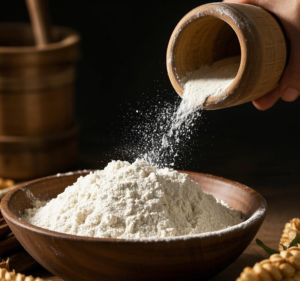Physical Address
304 North Cardinal St.
Dorchester Center, MA 02124
Physical Address
304 North Cardinal St.
Dorchester Center, MA 02124
When it comes to baking and cooking, the choice of flour can make a significant difference in both the texture and nutritional value of your dishes. Two commonly used types of flour are wheat flour and whole wheat flour. While they may seem similar at first glance, there are notable differences between the two that can impact your recipes and your health. In this article, we’ll explore the distinctions between wheat flour and whole wheat flour, their nutritional profiles, and how they can be used in your favorite recipes.

Wheat flour is a finely ground powder made from wheat grains. It is a staple ingredient in many cuisines worldwide, used in everything from bread to pastries, pasta, and cakes. However, not all wheat flour is created equal. The key difference lies in how the wheat grain is processed.
Standard wheat flour is typically made from the endosperm of the wheat grain, which is the starchy part of the kernel. This type of flour is often referred to as “all-purpose flour” or “plain flour.” It is widely used in baking because it provides a light and fluffy texture. However, the process of refining wheat flour removes two important parts of the grain: the bran (the outer layer) and the germ (the nutrient-rich core). This refining process strips away many of the natural nutrients, fiber, and healthy fats that are present in the whole grain.
Whole wheat flour, on the other hand, is made from the entire wheat grain, including the bran, germ, and endosperm. This means it retains all the natural nutrients, fiber, and healthy fats that are lost in the refining process of standard wheat flour. As a result, whole wheat flour is considered a healthier option compared to its refined counterpart.
The bran of the wheat grain is rich in dietary fiber, which promotes digestive health and helps you feel full longer. The germ contains essential vitamins, minerals, and healthy fats, including vitamin E, magnesium, and omega-3 fatty acids. By using whole wheat flour, you can enjoy these benefits while still achieving delicious results in your baking.
Nutritional Differences Between Wheat Flour and Whole Wheat Flour
The nutritional differences between wheat flour and whole wheat flour are significant. Here’s a breakdown of what you can expect:
How to Use Whole Wheat Flour in Your Cooking
Whole wheat flour can be used in a variety of recipes, from bread and pasta to pancakes and cookies. However, it has a denser texture and a slightly nuttier flavor compared to refined wheat flour. To achieve the best results when using whole wheat flour, consider the following tips:
Why Choose Whole Wheat Flour?
Choosing whole wheat flour over standard wheat flour can have numerous health benefits. By retaining the bran, germ, and endosperm, whole wheat flour provides a more complete nutritional profile. It is an excellent source of fiber, vitamins, and minerals, making it a healthier choice for those looking to improve their diet.
Additionally, whole wheat flour has a lower glycemic index (GI) compared to refined wheat flour, which means it causes a slower rise in blood sugar levels. This makes it a better option for people with diabetes or those looking to maintain stable energy levels throughout the day.
How to Select the Best Whole Wheat Flour
When purchasing whole wheat flour, it’s important to choose a high-quality product. Look for flour that is labeled as “100% whole wheat” to ensure that you’re getting the full nutritional benefits. Avoid products that are labeled as “wheat flour” or “enriched flour,” as these are typically refined and lack the essential nutrients found in the bran and germ.
You can also check the color and texture of the flour. Whole wheat flour should have a slightly darker color and a coarser texture compared to refined wheat flour. This is a good indicator that it hasn’t been overly processed.
Conclusion
In summary, the difference between wheat flour and whole wheat flour lies in how the wheat grain is processed. While standard wheat flour is stripped of its bran and germ during refining, whole wheat flour retains these nutrient-rich components. This makes whole wheat flour a healthier choice for those looking to incorporate more fiber, vitamins, and minerals into their diet.
Whether you’re baking bread, making pasta, or experimenting with new recipes, whole wheat flour is a versatile and nutritious ingredient that can elevate your dishes while supporting your overall health. So, the next time you’re at the grocery store, consider swapping refined wheat flour for whole wheat flour and enjoy the benefits of a more wholesome and nourishing meal.